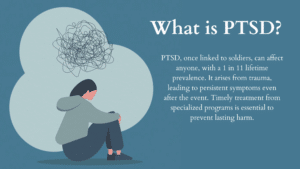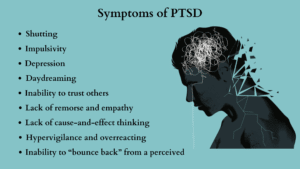People frequently associate PTSD or Post-Traumatic Stress Disorder with specific groups of people. Soldiers serving in times of war, police officers, first responders, and others who face difficult and potentially deadly situations as part of their employment requirements are generally those people who come to mind when we think of the signs of PTSD. But PTSD can happen to anyone, and there are many examples of trauma that may lead to PTSD development. During any given year, approximately 15 million American adults experience PTSD.
Are You Ready to Conquer PTSD?
What is PTSD?

PTSD has long been associated with soldiers and military veterans, so much so that it was once referred to as “shell shock.” But PTSD can happen to anyone, at any age. Some statistics suggest one out of every eleven people will be diagnosed with PTSD in their lifetime. Post-traumatic stress disorder is a mental health condition that develops in those who have experienced or witnessed a traumatic event. While trauma often leads to fear and other symptoms in most cases, someone with PTSD will experience symptoms related to the event long after the trauma has resolved. Without treatment at a mental health program specializing in PTSD, the impacts of trauma can cause long-lasting harm.
Common signs and symptoms of PTSD
Recognizing the signs and symptoms of PTSD is essential for early intervention and support. While the specific symptoms can vary from person to person, several common indicators may suggest the presence of PTSD. It’s important to note that not everyone with PTSD will experience the same symptoms, and some individuals may exhibit additional signs that are not listed here. However, being aware of these common signs can help us identify and support those who may be struggling with PTSD.

1. Re-experiencing symptoms: People with PTSD often relive the traumatic event through distressing memories, nightmares, or flashbacks. These intrusive thoughts can be triggered by various stimuli, such as sights, sounds, or smells associated with the trauma. Individuals experiencing re-experiencing symptoms may feel as if they are back in the traumatic situation, causing significant distress and emotional upheaval.
2. Avoidance and numbing: Individuals with PTSD may actively avoid reminders of the traumatic event, including places, activities, or people associated with the trauma. This avoidance behavior serves as a coping mechanism to protect themselves from distressing memories or emotions. Numbing of emotions and disinterest in previously enjoyed activities are also common symptoms of PTSD.
3. Hyperarousal and hypervigilance: People with PTSD often experience persistent feelings of being on edge or constantly on guard. They may have difficulty sleeping, become easily startled, or have a heightened startle response. Hypervigilance, or an increased awareness of potential threats, can make it challenging for individuals with PTSD to relax or feel safe in their surroundings.
Recognizing these common signs of PTSD is crucial for understanding and supporting individuals who may be silently struggling with this condition. By providing a safe and empathetic environment, we can help facilitate their healing journey and improve their overall well-being.
The impact of PTSD on mental health
PTSD not only affects an individual’s mental health but also has a significant impact on their overall well-being. The symptoms of PTSD can interfere with daily life, relationships, and work or academic performance. The emotional toll of living with PTSD can lead to feelings of isolation, depression, anxiety, and reduced quality of life.
Individuals with PTSD may also be at an increased risk of developing other mental health conditions, such as substance abuse disorders or mood disorders. The co-occurrence of these conditions can further complicate the recovery process and require comprehensive treatment approaches.
Understanding the profound impact of PTSD on mental health emphasizes the importance of early intervention and appropriate support. By seeking professional help and implementing effective coping strategies, individuals with PTSD can begin to reclaim their lives and achieve a sense of well-being.
What can cause PTSD?
PTSD is rooted in trauma. However, what trauma looks like is different from person to person. It is not necessary to directly experience or witness trauma to develop PTSD. Some people, especially youth and teens, develop post-traumatic stress disorder after learning about a traumatic event that happened to a friend or loved one. Several examples of events or situations that may cause trauma, such as severe injury or illness, terrorism, assault, abuse, natural disasters, death of a friend or loved one, witnessing violence, and engaging in military combat.
It is important to note that not everyone who experiences or witnesses trauma will develop post-traumatic stress disorder. Some data suggests one in three people who experience severe trauma will develop PTSD, but statistics vary. There are certain individual factors that may increase one’s risk for developing PTSD, including further trauma after the event, limited (or no) support from loved ones after the event, and a history of other mental health conditions such as depression or panic disorders.
Coping strategies for individuals with PTSD
In addition to professional help, individuals with PTSD can benefit from implementing coping strategies to manage their symptoms and improve their overall well-being. While not every coping strategy works for everyone, exploring different techniques can help individuals find what works best for them. Here are some coping strategies that may be helpful:
1. Self-care routine: Establishing a self-care routine that includes activities such as exercise, healthy eating, adequate sleep, and relaxation techniques can help reduce stress and promote overall well-being.
2. Support groups: Joining a support group for individuals with PTSD can provide a sense of community and understanding. Sharing experiences and learning from others who have gone through similar challenges can be incredibly empowering.
3. Mindfulness and meditation: Practicing mindfulness and meditation can help individuals reduce anxiety, increase self-awareness, and improve their ability to manage distressing thoughts or emotions.
4. Creative outlets: Engaging in creative activities such as writing, painting, or playing a musical instrument can serve as a form of self-expression and provide a healthy outlet for emotions.
5. Establishing a support system: Building a strong support system of trusted friends, family, or support groups can provide individuals with a network of people who understand their experiences and can offer support when needed.
These coping strategies, combined with professional help, can empower individuals with PTSD to regain control over their lives and enhance their overall well-being.
Your Path to Recovery Begins Here
How to Treat PTSD
While the symptoms and severity of PTSD symptoms vary from person to person, the most effective treatment, the first step in treating PTSD, is choosing a treatment program like Relevance Recovery, where providers understand the unique and wide-ranging recovery challenges associated with PTSD.
Several treatment models are used to help manage and overcome PTSD, including talk therapy, medications, and lifestyle changes. Three psychotherapy or talk therapy interventions are widely used in PTSD treatment; cognitive-behavioral therapy (CBT), exposure therapy, and Eye Movement Desensitization and Reprocessing (EMDR) therapy. Because each treatment addresses PTSD symptoms differently, it is important to work closely with your mental health provider to choose the treatment that is best for you. In some situations, antianxiety medications might be used to help reduce the intensity of certain symptoms during treatment.
If you or a loved one struggles with PTSD, seeking help to understand your symptoms can help. Without treatment, PTSD can have a significant impact on your physical and emotional health as well as your personal and social relationships. Everyone seeking help with PTSD has unique needs, and what works for one person, may not work for everyone. Let the team at Relevance Recovery help you begin your journey towards overcoming PTSD. Contact us today to learn more.









